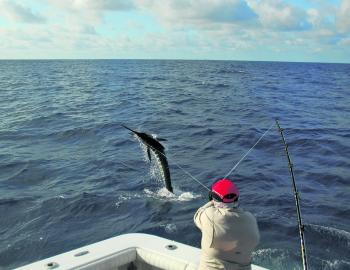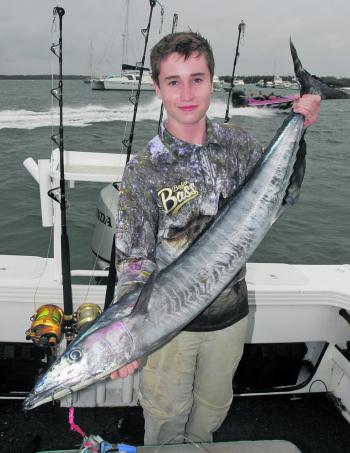April is a good month to chase mackerel, wahoo and blue marlin off the Gold Coast. As the current slows a bit and the water temperature drops a few degrees the bottom fishing also improves on the 36 and 50 fathom line. This season has been a very erratic one for game fishers in this area. Strong southeasterlies have made it difficult to get out, and a lot of the fish headed south and missed the Gold Coast grounds. Despite this, there have been patches of really good fishing when conditions allowed.
The wide grounds are a good option this month for anglers chasing blue marlin. If you look at the Sea Surface temperature charts, you will notice that the East Australian Current generally starts to slow down a bit and large circular eddies of warm water develop along the continental shelf. The edges of these eddies are excellent spots to chase big marlin.
So far this season, most of the action has been in depths of 200-300m just on the edge of the continental slope. The best method is to troll large skirted lures on 37kg tackle. In April most boats average about 2-4 marlin strikes a day. These fish are predominately blue marlin, but there have been quite a few striped marlin caught this year. By-catch in April includes wahoo and the odd yellowfin tuna.
The blues caught have averaged around 130-150kg, with roughly one fish in ten over 180kg or bigger. These are very challenging to catch from a small boat! Good lures include Black Snacks, Pakulas, Meridians and Tornado lures. It is a very challenging way to fish, and nothing empties a reel faster than a blue marlin on its initial run.
Wahoo are another good target species this month and there have been quite a few caught already this season. Try trolling fast metal headed lures like Hex Heads at around 12 knots, live-baiting with live tuna or trolling high speed minnows. The Tweed Nine Mile, the Mud Hole and the 36-fathom line are all good spots to chase wahoo. These speedsters tend to bite well when the current is flowing hard, and they are very active around the edges of any schools of small tuna.
In closer to shore there should be some big Spanish mackerel on Palm Beach and Mermaid Reefs this month, as well as spotted mackerel. Trolling large dead baits such as tailer, bonito or big slimies is extremely effective. High speed spinning with metal lures also works well, particularly when you locate the fish on the sounder. A good spot to try this is on the high pinnacles at the southern end of the 24-fathom reef east of Southport.
Bottom fishing improves a lot this month and can be quite productive on the 50-fathom line. There should be a few pearl perch, snapper, amberjack and pigfish around this month – if the current slows. The 36-fathom line produces juvenile snapper, pearl perch and teraglin. A few mulloway also show up on the inshore grounds. Most of these are caught on live-baits fished at night.
April is a transition month in the estuaries as the water cools off and the first westerlies start to blow. At this time of year a lot of bigger mangrove jacks start to move to the Seaway area prior to moving offshore. These fish are generally 50-60cm long. At times there are quite big schools of jacks in the area around the end of the north wall of the Seaway. These fish are hard to target, as they don’t stray far from the rocks. Small live-baits are often effective but don’t let the fish run far with the bait and strike hard when they take.
There should also be quite a few small to medium sized mulloway in the Seaway and Jumpinpin entrances with the odd bigger fish emerging. Live pike are one of the deadliest baits to try and account for most of the bigger fish. Deep jigged soft plastics are also effective. The best time to work these areas for mulloway is on the first hour and last hour of the run-in tide. On smaller tides the drift is generally easier to manage. Catching live pike can be a bit of a challenge. I recommend looking for areas of weed beds surrounded by clean sand in depths of 2-3m, and work small soft plastics or hardbodied minnows around the edges of the weed.
Whiting are another good option and it has been a very good season this year. The Pimpama and Nerang rivers have fished well for whiting and worms – yabbies and surface poppers have been effective. If you are after whiting on surface lures, wait for a windy day. This creates a bit of chop and slop in the shallows and small shrimp and prawns have to move away from the wavy edges when the wind is up. At these times the whiting can be quite ferocious. I like to use small stick baits like the SugaPen and wind the lure quite quickly with a jerky retrieve. This method also catches bream, pike, tailor and trevally. The first of a run-in tide seems to be the best time in the Broadwater, and the top half of the tide works well up the rivers where you can work the mangrove fringes.
Mud crabs and sand crabs should be active this month, particularly if we get good rainfall. For sand crabs, work the area between Crab Island and the Aldershots; for mud crabs, it’s hard to go past the Pimpama River or Coombabah Creek. The run-in tide is the best time to try.
Overall, April is a great month to fish the Gold Coast and there are plenty of good options to try both in the estuaries and on the offshore grounds.
Reads: 1412
It’s always awesome to witness an aerial show performed by a big marlin!

The wide grounds are a good option this month for anglers who want to chase a blue marlin.

This is the kind of welcome by-catch April delivers – wahoo!




